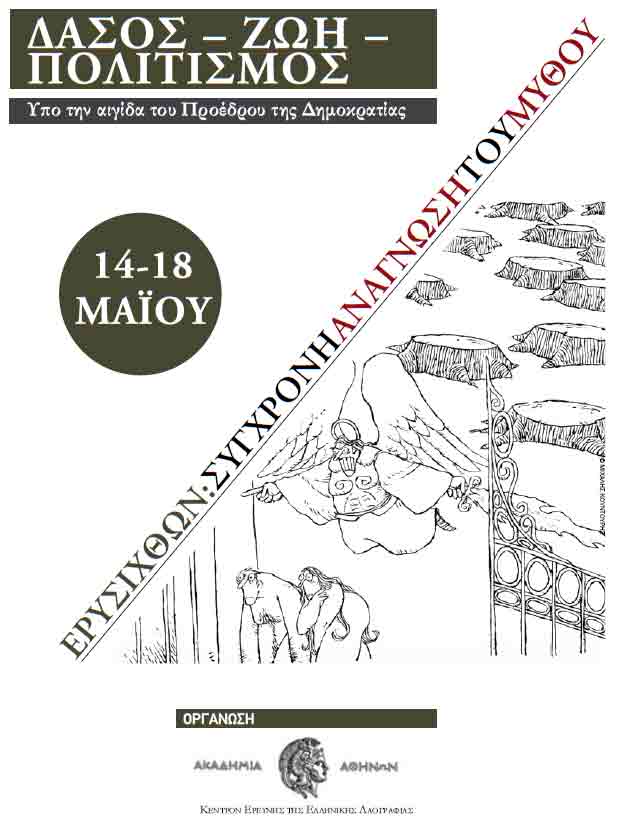

Duration: May 14 - May 18, 2010
On the occasion of the celebration of the Night and the Museum Day, in May, the Museum of History and Cultural Institutions of the Historic Center of Athens organizes the first great common
action of its members by proposing Visual Walks, at the premises of the members of the Network where hosted parts of the exhibition.
Organization
Hellenic Folklore Research Center of the Academy of Athens
under the auspices of the President of the Republic
Scientific Research Aikaterini Polymerou Kamilaki, Director of the Folklore Center of the Academy of Athens
Editor-in-Chief Louisa Karapidaki, art historian, permanent collaborator of the Folklore Center)
with the support of the Museum of History and Cultural Institutions of the Historic Center of Athens
and the Natural History Museum
The spaces and artists of the exhibition
Presidential Palace (Garden)
Aphrodite of Lithe
1. Academy of Athens
Panayiotis Tetsis, Spyros Kritikos
Sketch: Kountouris
2. Modern Ceramics Research Center - G. Psaropoulou Foundation
Apostolis Zolotakis
3. Museum of History of Greek Costume of the Lyceum of Greek Women
Eleni Tzatzalos, Venia Behraki
4. Museum of Greek Popular Musical Instruments F. Anogianakis
Thanasis Beroutsos
5. Herakleidon Museum
Aphrodite Liti, Apostolis Zolotakis
6. Museum of Greek Children's Art
Tassos Mantzavinos
7. Angelos and Leto Katakouzinos Foundation
Andreas Lolis
8. Jewelery Museum Elias Lalaounis
Alexandra Athanasiadis
Video: George Taxiaropoulos, Savvina Patrikio, Gregory Markatos
9. Spyros Vassiliou's Museum
Katharina Bolesch, ceramic
10. Historical Archive of the National Bank
Irene Gounou, Miltos Pantelias, Kallirroi Spyridon
11. Visual Arts & Music Foundation B. and M. Theocharakis
Chryssa Vergi, Maria Giannakaki
12. Museum of Political Exiles
Katerina Hariata Sismani
13. Jewish Museum of Greece
Aphrodite of Lithe
14. Frissiras Museum
Kalliroi Marouda
15. Hellenic American Union
Charis Kontosfiris, Christos Charisis, Giorgos Tseroni, Venia Behraki, Magda Tamam, Eleni Tzatzalos, Petros Vrelis, Konstantina Katrakazou, Stefanos Zannis, Ioanna Rali
THE STATEMENT OF THE REPORT
We usually say that "nature punishes". But nature has no feelings to anger and punish. What seems to us as a punishment is the reaction that our actions cause when disturb the balance of its elements. Man's interventions, when they are directed by greed, hatred and recklessness, are dangerous, be it the destroying a forest or an alsyl, or contaminating the atmosphere, rivers and seas.
The myth of the Thessalian Erysithon, preserved by the poet Kallimachos, shows that ancient ancestors had realized that man towards nature must be careful and pious because will sooner or later suffer the consequences of his actions. Erysichthon was an advantageous, profane and ungodly man. One day he was forced to cut a sacred tree of Demeter. Despite the and the warnings of the nymph that inhabited it, he formed the tree. For his punishment, Demetra sent him an insatiable hunger that was not satisfied with anything. She ate what she had and did not, he spent all his riches to buy all the goods of the earth and eat them. He sold his own daughter, the witch Mistra, to buy food. He finally ate his own the members and died, without ever satisfying his hunger. The myth symbolizes the irresponsibility, the reckless exploitation of natural resources, symbolizes the modern man who without measure consumes unsaturated and above his normal needs, depriving the future of children - the forms of which his daughter takes - and all the alive of nature and eventually eating his own flesh and leads to the extinction.
